In a bold move that has sparked both curiosity and concern, language-learning app Duolingo has recently made significant changes to its workforce, replacing human writers and translators with artificial intelligence (AI) technology. This decision, aimed at increasing productivity and efficiency, has raised questions about the future of AI in the language learning industry and the potential implications for the quality of educational content. In this article, we will explore the impact of Duolingo’s transition to AI, the motivations behind this decision, and the challenges and opportunities it presents.
The Shift Towards AI: Duolingo’s Controversial Move
Duolingo, a leading language-learning app founded in 2011, has gained significant popularity over the years, boasting 83.1 million monthly users as of September 2023. Despite its success, the company has faced criticism for its recent decision to replace contract writers and translators with AI technology. The move, which resulted in several waves of layoffs throughout 2023, has raised concerns about the quality of content and the future of human workers in the industry.
The company’s spokesperson, Sam Dalsimer, confirmed that Duolingo terminated approximately 10 percent of its contractors at the end of 2023, but declined to provide specific numbers. The cuts affected teams working on multiple language programs, impacting the quality and accuracy of lessons. Former workers, such as Benjamin Costello, a Russian-language translator and musician, expressed their disappointment, noting numerous errors in the app’s content since their departure.
The Role of AI in Language Learning
The rise of AI in the language learning industry is not unique to Duolingo. Companies worldwide have been exploring how AI chatbots can be utilized to create human-sounding text on various topics. The ability of these bots to generate content quickly and efficiently has attracted marketers and online publishing companies, leading to the replacement of human writers in certain roles.
While AI has proven useful in translation services, it still faces limitations and requires human intervention to correct errors. Critics argue that the cost-saving benefits of AI are driving companies to prioritize efficiency over quality, potentially compromising the learning experience for users. However, proponents of AI assert that it can be a valuable tool for increasing productivity and developing new content at a faster rate.
Duolingo’s Journey with AI Integration
Duolingo’s decision to embrace AI did not come as a complete surprise to its former contractors. Despite initial assurances that AI would not replace human workers, the company began testing AI internally in early 2023. In August of that year, contractors working on less popular language programs were laid off, and a larger wave of layoffs occurred in December, affecting more popular and higher-quality lesson programs.
The company gradually introduced AI features into its app, including a conversation mode built with OpenAI’s GPT4 technology. AI was also employed to generate sentences for lessons that were previously written by human contractors. While Duolingo claims that humans still lead the development of its app, concerns have been raised by current employees who fear that their jobs may also be at risk if AI continues to improve.
The Impact on Language Learning Quality
One of the primary concerns surrounding Duolingo’s shift towards AI is the potential decline in the quality of language learning content. Former contractors have reported numerous errors in the app’s lessons since their departure, suggesting that AI-generated content may not meet the same standards as human-created content. This raises questions about the effectiveness of AI in language learning and the value it provides to users.
Duolingo’s spokesperson, Sam Dalsimer, emphasized that the company aims to use AI as a tool to increase productivity and efficiency while improving its courses. However, critics argue that the removal of human expertise from the content creation process could have significant consequences for the learning experience. The absence of human editors and translators may result in inaccuracies, cultural insensitivity, and a lack of nuance in language lessons.
The Future of AI in Language Learning
While Duolingo’s transition to AI has sparked debate and skepticism, it is just one example of the growing trend of integrating AI into the language learning industry. As AI technology continues to advance, it has the potential to revolutionize the way people learn languages. AI-driven chatbots can provide personalized learning experiences, adapt to individual needs, and offer real-time feedback to learners.
However, it is crucial to strike a balance between AI and human expertise to ensure the highest quality educational content. Human editors and translators play a vital role in refining and enriching language lessons, providing cultural context, and addressing the unique challenges learners may encounter. The successful integration of AI in language learning will require ongoing collaboration between humans and machines to create a comprehensive and effective learning experience.
The Broader Implications of AI in the Workforce
Duolingo’s move towards AI highlights the broader implications of automation and AI technology in the workforce. While advancements in technology create new job opportunities, they also pose challenges for workers whose roles can be automated. Gig and freelance workers, in particular, may be more vulnerable to job displacement as companies prioritize cost-saving measures.
Studies have shown that the introduction of AI can lead to a decline in job postings for positions that are susceptible to automation. This disruption affects not only lower-paid entry-level positions but also creative roles such as writing and graphic design. The impact of AI on the job market is unpredictable and raises questions about the future of work in an increasingly automated world.
The Ethical Considerations of AI Integration
The integration of AI in language learning and other industries also raises ethical considerations. The use of AI technology, particularly in the training and development of AI models, has drawn criticism from authors and organizations who claim that their work has been used without permission or proper compensation. Intellectual property rights, plagiarism, and the responsible use of AI are essential considerations in the ongoing development and implementation of AI technology.
Recently, the New York Times sued OpenAI, the developer of ChatGPT, alleging that the AI language model had plagiarized its news stories. Such legal disputes highlight the importance of establishing ethical guidelines and regulations for AI to protect the rights of content creators and ensure the integrity of AI-generated content.
The Road Ahead: Balancing AI and Human Expertise
As the language learning industry and other sectors continue to explore the potential of AI, finding the right balance between AI and human expertise will be crucial. While AI technology can bring efficiency and scalability to content creation, it should not replace the invaluable contributions of human editors, translators, and educators.
Companies like Duolingo must prioritize the quality of educational content and ensure that AI-generated lessons undergo rigorous human review and editing. The ongoing collaboration between humans and machines can lead to innovative approaches that enhance the language learning experience, leveraging the strengths of both AI technology and human expertise.
In conclusion, Duolingo’s transition to AI marks a significant development in the language learning industry. While the integration of AI has the potential to revolutionize language learning, concerns about the quality of content and the future of human workers persist. Striking a balance between AI and human expertise will be crucial to ensure the highest quality educational experiences for language learners. As advancements in AI technology continue, it is essential to address the ethical considerations and implications for the workforce, fostering responsible AI development and implementation.
See first source: Washington Post
FAQ
Q1: What significant changes has Duolingo made to its workforce?
A1: Duolingo has replaced human writers and translators with artificial intelligence (AI) technology as part of its workforce, a move that aims to increase productivity and efficiency.
Q2: Why did Duolingo make this decision to transition to AI technology?
A2: Duolingo’s decision to transition to AI technology was driven by the goal of improving productivity and efficiency. It aimed to harness AI to create language learning content.
Q3: What concerns have arisen due to Duolingo’s shift to AI in content creation?
A3: Concerns have been raised about the potential decline in the quality of language learning content as a result of AI-generated content. Some worry about the future of human workers in the language learning industry.
Q4: How has AI been used in the language learning industry beyond Duolingo?
A4: AI technology has been explored in the language learning industry globally. AI chatbots are used to generate human-sounding text on various topics, including language lessons.
Q5: What challenges are associated with the use of AI in language learning?
A5: While AI can increase efficiency, it still faces limitations and may require human intervention to correct errors. Concerns include the prioritization of efficiency over quality and the potential for inaccuracies in AI-generated content.
Q6: What is the future of AI in the language learning industry?
A6: The future of AI in language learning holds the potential for personalized, adaptive learning experiences. However, it will require a balance between AI and human expertise to ensure the highest quality educational content.
Q7: What broader implications does Duolingo’s move towards AI highlight?
A7: Duolingo’s shift towards AI underscores the impact of automation and AI technology on the workforce. It raises questions about job displacement, especially for gig and freelance workers, and the ethical considerations of AI integration.
Q8: What ethical considerations arise from the integration of AI in content creation?
A8: Ethical considerations include intellectual property rights, plagiarism, and the responsible use of AI in content creation. Recent legal disputes, such as the New York Times suing OpenAI, highlight these concerns.
Q9: What should be the approach to balancing AI and human expertise in content creation?
A9: Balancing AI and human expertise requires prioritizing the quality of content and rigorous human review and editing of AI-generated materials. Collaboration between humans and machines can lead to innovative approaches that enhance the learning experience.
Featured Image Credit: Photo by Brett Jordan; Unsplash – Thank you!









